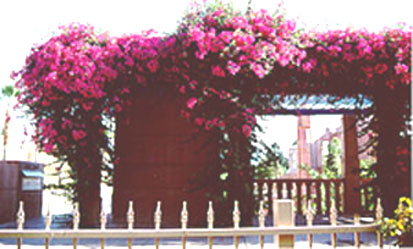Bougainvillea 'Barbara Karst'
 Common: Bougainvillea, Paper Flower
Common: Bougainvillea, Paper Flower
Family: Nyctaginaceae
Origin: Brazil
Sunset Zone: 22-24; also grown in zones of minimum frost (12, 13, 15-17, 19, 21)
Light: Full sun. Light shade in hottest areas.
Soil: Well drained soil; should not be water-logged.
Temperature: Most varieties thrive in hot weather. Reliably hardy in nearest we have to tropical climate.
Water: Little water once established
Climbing plant used for masses of color. Can be trained as ground cover, or planted in pots. Good for bank cover. Used on terrace or patio as summer annual. Nice screening plant, use as accent. Evergreen species in native or similar climate. Becomes deciduous in colder climates.
Climbing, thorny vines grow well on south and west walls. Most characteristic climber in hot climates such as Mediterranean, Southwest and the Indian subcontinent. Can get as large as 12 feet. Without support and corrective pruning, becomes broad, sprawling shrub.
Showy part of flower is formed by papery bracts surrounding true flower, which is small and inconspicuous. Colors range from red, magenta, pink, orange, yellow or white. Thrive in hot weather, some bloom almost continuously. Flower production comes so quickly that replacement of frost damage is not a deterrent.
The leaves have smooth margins. Vines make dense cover of medium-sized, medium green leaves. Extreme drought results in leaf fall. The root balls of this plant fragile and sensitive to disruption. Can be grown from stem cuttings, planted at an angle in a box containing sand and watered every day until roots and shoots appear. Horticultural varieties do not produce seeds. It is essential to achieve required shape and size. Done after flowering season or start of rainy season. Flowers will sprout from tips of new growth. In 1768, Admiral Louis de Bougainvillea began his long journey to the Pacific Ocean and discovered the vine that now bears his name. Plant is susceptible to iron chlorosis. Leaf and flower drops can be messy in late summer.